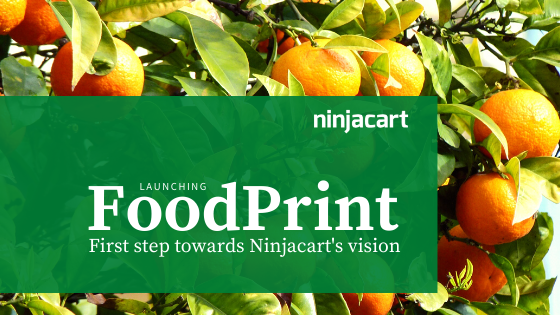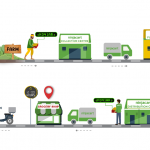A few years back, we were strongly convinced our technology and supply chain innovation will improve farmers’ lives and simplify retailers’ business. But we realized, Ninjacart is merely an efficiency company, trying to solve the problems in the food supply chain. Our existence didn’t impact billions of end consumers in any meaningful way.
Table Of Content
We soon realized food safety is a much bigger problem that is affecting us than the supply chain issues. What’s the point of getting a tomato from farm to home efficiently, if it is no longer safe to eat. It’s funny how humanity put a man on the moon before ensuring safe food for everyone on this planet. From 2018, Safe food for billion people became the purpose of our existence (Read: Why Ninjacart Exists — Published in 2018). For us achieving this goal is not just an opportunity but a necessity.
Our approach to safer food for billion people is to provide zero residue food [Food produced with optimal farm inputs and has low Maximum Residue Limit (MRL)] than pure organic food — because it is practical, scalable and affordable. Zero residue food could unlock safer food for billions of people.
When we set ourselves on an audacious goal of making food safe for a billion people — we knew it will be a decade long endeavour to make a change that lasts forever. We will have to invest in technology, supply chain infrastructure, and desired behaviours that might payoff after a decade. But the best time to start is now. Back in 2018, we chalked out 4 steps to get there.
Path to Safe Food for Billion people

- FoodPrint — Build a robust, end-to-end food traceability infrastructure to capture complete details of the food origin and its journey from farm to home.
- FarmPrint — Build a farm inputs and best practices monitoring tool to check what goes into the Farm to produce a vegetable, enforcing farmer to follow Good Agricultural Practice (GAP) and lower maximum residue limit (MRL).
- ResiduePrint — Build a scalable, high throughput and cheaper residue measurement tool to check the residues of all products purchased by Ninjacart to ensure only the safest product makes way to the retailers.
- Affordability—Above innovations are useless if it is expensive and serves only a niche customer segment. Making it scalable and sustainable is the way to take to billion-plus people of India.
Step 1: Launching FoodPrint
We have been working on Foodprint infrastructure for the past 2 years. Foodprint is a foundational information highway that allows us to know everything about the food we eat. Starting from, who is the farmer, when was it harvested, the truck that carried the produce, the warehouse that processed it, the helper who handled the product at the warehouse, a retailer who brought the product and how it was delivered to your doorstep.

Why this is important?
Imagine, there is an outbreak of serious food safety, quality issues, or we detect food with high residue, we can identify the origin of the issue in hours and act on it immediately. The 100% traceability helps us control the quality in each and every step and monitor how your product is handled in the entire supply chain with a robust and instant feedback loop. In simpler terms —You have someone to hold accountable for the quality of the food you eat.
How Food Traceability works
- The farmer brings the produce to our collection center (watch: How Ninjacart works), where it is transferred to Ninjacart crates with RFID tag — FoodPrint ID gets assigned to the Farmer and the produce.
- In our entire supply chain, the vegetable is not touched and carried in the same crate until it reaches the retailers, thus keeping the FoodPrint-ID intact.
- At the retailer point, when the item is packed for the customer, the respective traceability ID is mapped to the customer order.
Holding Farmers accountable
It’s sad, how we have so much regulation around the manufacturing of material goods from cars to cosmetics, but nothing for the food we eat. The sad state of India’s fresh food (vegetable and Fruits) production and marketing focuses on quantity and visual appeal rather than the real safety of the products.
Problem — Farmers are not held accountable, leading to the poisoning of our foods slowly. With Foodprint, we can now hold farmers accountable for high residue food, quality issues, and bad agricultural practices. At the same time, we can reward them for producing safer and quality products.
Launching Foodprint Viewer
We are working on an exciting new feature — FoodPrint viewer, where you can know your farmer and how the food travelled from the farm to your home. For the products, you order from Ninjacart’s partner grocery store through Swiggy, Zomato, Dunzo, and other online platforms, you would be able to view the Foodprint data. The coolest aspect of the Foodprint viewer is you can send appreciation/feedback to the exact farmer, who produced your food. We are launching the food viewer on June 7, 2020, on World food safety day. With this launch, we are one inch closer to our Vision.
P.S: Let us know what information you would love to see about your food
Update on Next Steps
- FarmPrint: Currently in the beta phase, where we are developing know-how to producing zero residue food. We are building tools to monitor everything from seed to harvest in select farms — tracking seed variety, what & how much fertilizers/pesticides were used, and Adherence to GAP.
- ResiduePrint: In its early-stage development, we are developing a scalable and cheaper protocol to measure the levels of residues in the products procured from farmers.
But, these are time taking to make it durable and scalable. It might take another 3 to 4 years to get safe food with the highest possible reliability on the plate of the first million customers in the context of India’s ecosystem. Till then, we are back to work — to get safe food for billion people (maybe more, due to Covid-19).
. . .
Written by
Thirukumaran Nagarajan
CEO & Co-founder of Ninjacart




No Comment! Be the first one.